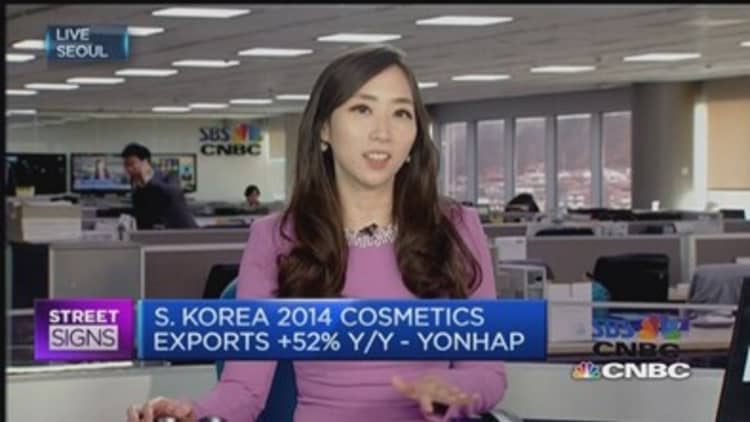South Korean stocks are underperforming their regional peers this year, but one bright spot has emerged as the country's cultural exports gain popularity overseas: consumer stocks.
AmorePacific Group and LG Household & Healthcare (LG H&H) – the country's top cosmetics makers – outperformed last year, rallying 183 and 16 percent respectively. By contrast, traditional Kospi index heavyweights Samsung Electronics and Hyundai Motor fell nearly 5 and 30 percent as cut-throat competition weighed on sales.
That trend appears unlikely to change as Hallyu – the Korean term for the popularity of South Korean pop-culture abroad – continues to spur the fashion and tourism industries. The meteoric success of last year's K-drama "My love from the Star" boosted sales of luxury items and cosmetics adorned by lead actress Gianna Jun. For one, a neon orange lipstick by AmorePacific's beauty brand Laneige sold out in countries including China and Singapore.
According to government data, South Korea's cosmetics exports surged 52 percent on-year in 2014, amid increased demand from China. This underpinned 52 and 31 percent jumps in AmorePacific and LG H&H's operating profit, respectively, last year.
"if you look at Chinese inbound travel into Korea, it's proof that Seoul (and Jeju) are now firmly on the map and anything Korean is cool in the eyes of Chinese (and many other Asian) consumers," Erwan Rambourg, managing director and global co-head of consumer and retail at HSBC, told CNBC. "Also, many of the successful brands are just starting to develop in terms of awareness so I believe [in terms of sales] they still have legs."

Wave to grow or break?
AmorePacific and LG H&H stand out as "good long-term investments," says CLSA, as their cosmetics products will likely enjoy increasing popularity among China's middle class.
"We expect [both companies'] profits to grow as more Chinese tourists buy their products in Korea [and as] they expand their market shares in China," Oliver Matthew, head of Consumer Japan & Korea, Japan Telecom, Media and Internet at CLSA, wrote in an email to CNBC.
Read MoreKeep faith in South Korean shares? Maybe not, say experts
Credit Suisse, which has an "outperform" rating on LG H&H, agrees: "The rapid growth of beauty brands should raise investors' confidence given this is good indication of LG's potential in overseas market. Recent sales data also suggest the growing popularity of LG's household goods among the Chinese," analysts wrote in a note.
But Daewoo Securities' analyst Regina Hahm, who has a buy rating on both stocks, sounded a note of caution: "LG H&H lacks capabilities in marketing. So while their products are good in quality, they are less well-known and not forgetting, challenges remain in its beverage division."
Meanwhile, Hahm says shares of AmorePacific may have "overshot… as of late" and could see a pullback before reaching a target price of 3,100,000 over the next 12 months. AmorePacific and LG H&H finished at 2,762,000 and 653,000 won on Tuesday.
Other top picks
Another market darling is duty-free shop operator Hotel Shilla, which Daewoo Securities believes has the biggest upside potential in the consumer space this year. Daewoo's target price of 162,000 won, which represents a 70 percent upside from current trading levels, is premised upon continued improvements in the domestic market and overseas expansions.
Meanwhile, CLSA's Matthew has a "buy" rating on department store giant Shinsegae despite a gloomy retail market. While sales at South Korea's top department and discount stores rebounded sharply in February due to the Lunar New Year holiday, combined sales fell for five straight months prior to that, with January's department store sales marking the steepest contraction on record.
"Some companies are beneficiaries of the Korean Wave, but certainly not all. We prefer consumer stocks with high exposure to women spending, strong pricing power and profitable opportunities [in China]," said CLSA's Matthew, who has a target price of 230,000 won for Shinsegae, representing a 32 percent rise from where the stock closed on Tuesday.
"Shares [of Shinsegae] are too cheap and their profits will grow again in 2015," he added.

